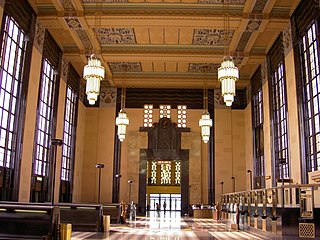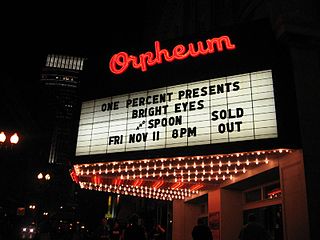
The Old Market is a neighborhood located in downtown Omaha, Nebraska, United States, and is bordered by South 10th Street to the east, 13th Street to the west, Farnam Street to the north and Jackson Street to the South. The neighborhood has many restaurants, art galleries and upscale shopping. The area retains its brick paved streets from the turn of the 20th century, horse-drawn carriages, and covered sidewalks in some areas. It is not uncommon to see a variety of street performers, artists, and other vendors.

The Union Station, at 801 South 10th Street in Omaha, Nebraska, known also as Union Passenger Terminal, is "one of the finest examples of Art Deco architecture in the Midwest". Designated an Omaha Landmark in 1978, it was listed as "Union Passenger Terminal" on the National Register of Historic Places in 1971, and was designated a National Historic Landmark in 2016. The Union Station is also a contributing property to the Omaha Rail and Commerce Historic District. It was the Union Pacific's first Art Deco railroad station, and the completion of the terminal "firmly established Omaha as an important railroad terminus in the Midwest".

The South Omaha Main Street Historic District is located along South 24th Street between M and O Streets in South Omaha, Nebraska. It was added to the National Register of Historic Places in 1989. Home to dozens of historically important buildings, including the Packer's National Bank Building, the historic district includes 129 acres (0.52 km2) and more than 32 buildings.

The Sherman is a historically significant apartment building located at 2501 North 16th Street in the Near North Side of Omaha, Nebraska. Built in 1897, it was designated an Omaha landmark in 1985; in 1986 it was listed on the National Register of Historic Places.

The Vinton Street Commercial Historic District is located along Vinton Street between Elm Street on the west and South 17th Street on the east in south Omaha, Nebraska. This district is located adjacent to Sheelytown, a residential neighborhood that had historically significant populations of Irish, Poles, and Eastern European immigrants. It grew along with the success of the Union Stockyards and South Omaha. It was added to the National Register of Historic Places in 2006.

The Melrose Apartments were built in 1916 at 602 North 33rd Street in the Gifford Park neighborhood of Omaha, Nebraska. The Melrose was listed on the National Register of Historic Places in 1989.
Sheelytown was a historic ethnic neighborhood in South Omaha, Nebraska, USA with populations of Irish, Polish and other first generation immigrants. Located north of the Union Stockyards, it was bounded by Edward Creighton Boulevard on the north, Vinton Street on the south, South 24th Street to the east, and 35th Street to the west. Sheelytown was named for the Sheely Brothers Packing Houses that were located in the area. Sheelytown was annexed by Omaha in 1887. The Omaha Quartermaster Depot was built just east of the community across the Union Pacific tracks.

The Prague Hotel is located at 1402 South 13th Street on the southwest corner of South 13th and William Streets in the heart of the Little Bohemia neighborhood of Omaha, Nebraska. Designed by Joseph Guth and built in 1898, this building was listed on the National Register of Historic Places in 1987.

Vinton School was built as a fourteen-room elementary school in 1908 at 2120 Deer Park Boulevard in the Deer Park neighborhood of Omaha, Nebraska, United States. Designed by Omaha architect Frederick W. Clarke, Vinton School is the earliest and most elaborate example of a Tudor Revival-style school in Omaha. Designated an Omaha Landmark in June 1990, the building was listed on the National Register of Historic Places in November 1989.

Mason School is located at 1012 South 24th Street in south Omaha, Nebraska, United States. Designed in the Richardson Romanesque style by the architectural firm of Mendelssohn, Fisher and Lawrie, the school was built in 1888 by the brick manufacturing and construction firm of Hadden, Rocheford & Gould. The school closed in the late 1970s and was converted into apartments. It was designated an Omaha Landmark in 1986 and listed on the National Register of Historic Places that same year.

The Beebe and Runyan Furniture Showroom and Warehouse is located at 105 South 9th Street in Downtown Omaha, Nebraska. The building was listed on the National Register of Historic Places on July 23, 1998, and is a contributing property to the Warehouses in Omaha Multiple Property Submission.

The Orpheum Theater is a theater located in Omaha, Nebraska. The theater hosts programs best served by a more theatrical setting, including the Omaha Performing Arts Broadway Season, presented with Broadway Across America, and Opera Omaha's season. The theatre is listed on the National Register of Historic Places. The main auditorium is a proscenium theater known as "Slosburg Hall". The theater has a theatre organ, made by Wurlitzer.
John Latenser Sr. (1858–1936) was an American architect whose influential public works in Omaha, Nebraska, numbered in the dozens. His original name was Johann Laternser.
Mendelssohn, Fisher and Lawrie was a significant architecture firm in early Omaha, Nebraska. Fisher & Lawrie continued. A number of their works are listed on the National Register of Historic Places.
The Armour Packing Plant was a division of Armour and Company located at South 29th and Q Streets in South Omaha, Nebraska. The plant opened in 1897 and closed in 1968. The plant included several buildings, including a remarkable red brick administrative building, and a large, tall wall which surrounded the facility. It was located on the South Omaha Terminal Railway, and next to the Omaha Stockyards, making Armour one of the "Big Four" packing companies in Omaha.
The Ford Warehouse, also known as the Simon Brothers Building, is located at 1024 Dodge Street in Downtown Omaha, Nebraska. It is a six-story brick and stone building constructed in 1919 and was added to the National Register of Historic Places in 1999. It is located near the Omaha Rail and Commerce Historic District and the site of the former Jobbers Canyon Historic District, and is three blocks from the Old Market Historic District. Additionally, the building is also in accordance with the patterns for significance detailed in the Warehouses in Omaha Multiple Property Submission.
Rocheford & Gould were brick manufacturers and construction contractors in early Omaha, Nebraska. The firm built numerous brick structures during Omaha's transition from the wooden buildings of Nebraska's territorial days to more permanent structures. The buildings the firm built included breweries, schools, packing houses, business blocks, Vaudeville theaters, street car barns and power houses, and civic buildings. Many of the structures the firm built have been demolished but a few of their earliest structures still exist and are listed on the National Register of Historic Places.

The Elsasser Bakery is a building at 1802 and 1804 Vinton Street in South Omaha, Nebraska. The building was built in 1923 for the William L. Elsasser Bakery. The Elsasser name is carved into a stone panel at the top of the red brick building. The building was added to the National Register of Historic Places in 2006 as part of the admission of the Vinton Street Commercial Historic District. The building's main occupant is currently the River City Saloon.
The World Theater was a vaudeville and movie theater at 1506 Douglas Street in downtown Omaha, Nebraska. Its name was changed to the Omaha Theater in February 1935 when it was sold to new management. It closed on February 26, 1978 and was razed in 1980 to allow for the construction of a parking garage.














